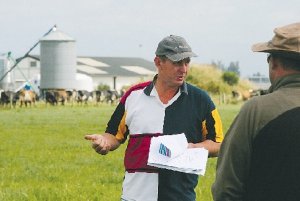Lister last year won the Canterbury region of the Dairy Business of the Year competition, and was only just pipped to the national title by fellow Cantabs the Davie-Martins, Culverden. His return on investment was 9.2%; theirs was 9.4%; the next closest finalist was on 7.4%.
How did he do it? Last month a DairyNZ discussion group from Fairlie, about 80km inland from Lister's property, visited him to gain insight.
He set the scene explaining how he'd come to lease and in due course buy a share of the farm from his father and grandfather, then, after some 17 years of cropping, converted it to dairy in 2006.
"I looked at all the options before going into dairy and it wasn't cut-and-dried. The payout forecast was only $4.70/kg or so and it was two years before we got the big payout, so it was risky enough."
With Lister working full-time on the farm the predicted profit was $55,000. "So it was touch-and-go, but that was still a lot more than cropping." That's despite the dairy development saddling the business with a lot more debt than it had as a cropping farm, he notes.
His first year's payout came in at $4.46/kgMS. Then came the then-record $7.90/kgMS in 2007/8. "That really set us up."
But as few who were farming in 2008/9 will need reminding, from an opening forecast of $7/kgMS, they ended up with $5.21/kgMS and the sobering forecast for 2009/10 of $4.55/kgMS. That was the year Lister took on managing the farm himself.
"For the first three seasons I had a manager here, and I was the boy. I did what the manager told me, even when I didn't agree. I just filed it away."
That looking and learning paid off. In his first season he lifted output nearly 10% to 448kgMS. Meticulous pasture management, taking covers down to 1500kgDM/ha without failing to ensure quality regrowth, while never letting cows go hungry, drove the lift, rather than any extra input.
"Putting the farm on a knife edge has lifted this from a 1600kgMS/ha farm to 1750kgMS/ha farm," Lister told the discussion group. "Our grass samples come back at 12.5MJ of ME when I know others around here are feeding 11 ME grass."
Target grazing cover is 2800 to 3000kgDM/ha. "After 3000kgDM/ha that paddock has a question mark over it and will probably go for baleage. I give myself two days, then ring up [the contractor]."
Where paddocks haven't been taken down to 1500kgDM/ha, the cows go back in the evening to clear it up. "Never during the day... milking them just makes them peckish enough to graze it down."
Even when a paddock has been cleared, the cows coming out of the shed don't get a fresh break until the whole herd is there.
"We move them as one. Otherwise the first ones back from the shed take the top off, then sit down and have a big sleep leaving the ones coming at the back to clear up."
Consequently, all cows are trained to eat down to 1500kgDM/ha, he argues.
Reseeding damaged patches of pasture is done with his own direct drill, if necessary using hot wire fences to keep cows off for one or two rounds until the new grass has taken. "We don't take whole paddocks out of the round."
Chicory, besides providing great grazing, is added to the seed mix at 1kg/ha so its tap root works as natural subsoiler. "We get about three years out of it. The cows always eat the chicory first."
The plough only comes out if a paddock is "so rough we can't get the fertiliser spreader in."
Nitrogen goes on as 75kg/ha of urea once soil temperature is 9oC in spring. The following round it will get 65-75kg/ha depending on appearance. "It sets up the tillers we're going to need later in the season. Then we pull back the nitrogen over Christmas and new year once those plants are established."
His most productive pastures are his fescues, which were seed crops for five years prior to going dairy. "So they're old pastures."
Despite that "they come up faster in the wedge so have a shorter return time.... If the whole farm was in fescue I'd have five cows/ha." The downside is fescue is hard and slow to establish, and very tender initially, he points out.
Lister says "a lot of Lincoln University Dairy Farm farm walks" and regular scrutiny of its website helped him develop his pasture management skills.
"I was always thinking 'what are they doing and why are they doing it?' Can we do the same things here?"
While Lincoln has moved on to its 'precision dairy' programme with slightly higher residuals this season, he's sticking to Lincoln's previously tried and tested formula. Where his system differs is in-shed grain feeding at the shoulders of the season.
"I usually buy about 200t of barley and 90t of PKE. This season we've used 60t of barley and 20t of PKE so we're well below what we normally use."
It's also his "safety net" for putting the farm on the knife-edge in respect of pasture cover carried. But with such high quality grass, grain is considered "no better than grass except for when we get growth rates over 85kgDM/ha/day."
The problem with such fast-growth grass is its bulk and water content. What appears to be a 3000kgDM/ha cover on the plate meter may only be 2500kgDM/ha, and there's only so much space for feed in a cow's stomach.
"If you can get a kilogramme of grain in it does lift the total ME you can get in there."
















